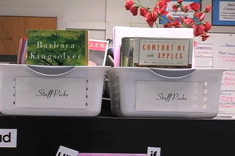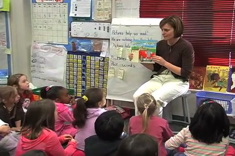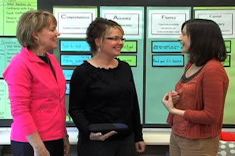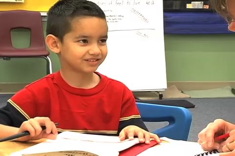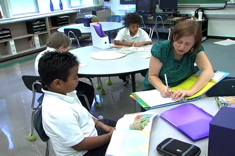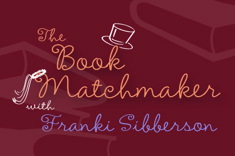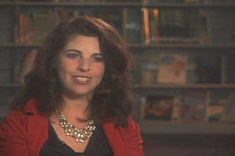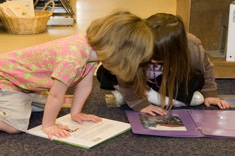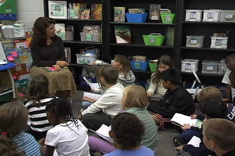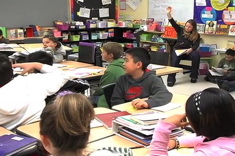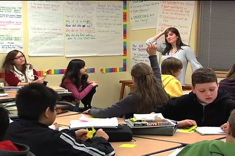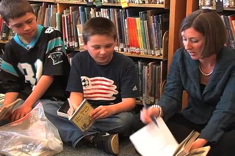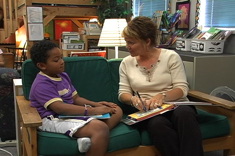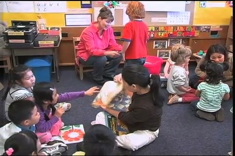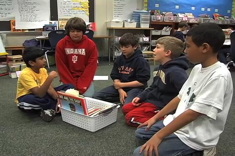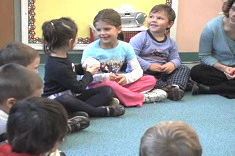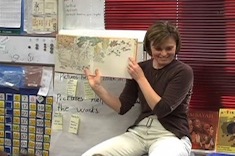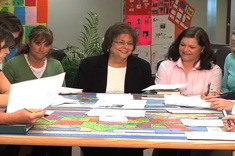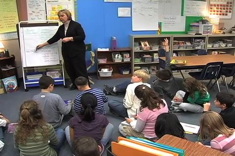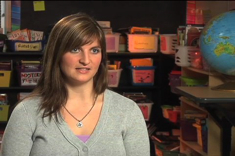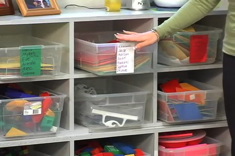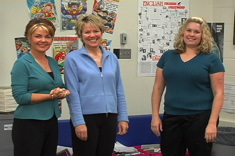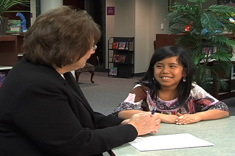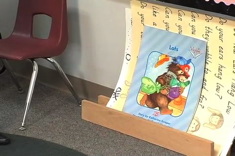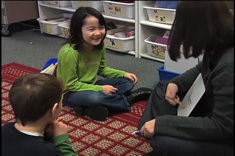Videos
Here is where you’ll find all the latest videos from our contributors. These videos are all captured in classrooms with crews using multiple cameras during regularly scheduled reading and writing workshops.
Latest Content
Building the Reading Community Among Teachers
Jennifer Allen shares a few strategies for building the reading community beyond individual classrooms in your school. Book swaps, a shared staff novel, and family literacy breakfasts all reinforce the most important aspect of reading – it should be pleasurable and engrossing, no matter the age of the learner.
Digging Deeper with Rereading
In this video from Katie DiCesare’s first-grade classroom, Katie uses the strategy of rereading to help students look more closely at words—in this case, words that rhyme.
When to Group?
Reading groups are such an ingrained element of our teaching culture that teachers can feel guilty if they choose other instructional methods. In this conversation with fourth-grade teacher Rachel, Joan Moser and Gail Boushey (“The Sisters”) talk about when it makes sense to group students.
Drawing to Words: Conferring with Luis
In this four-minute video, Andie Cunningham confers with Luis during writing workshop. Luis is a six-year-old English language learner whose passion is drawing.
Book Clubs: Setting the Stage with Conferring
We want students to discuss books in thoughtful, sophisticated ways in book clubs, but those skills don’t always come naturally. (Wait – do those skills ever come naturally?) Beth Lawson explains how she confers with individual children in her third-grade classroom to prepare them for independent book clubs with peers.
Book Matchmaker: Texts to Inspire Our Youngest Readers and Writers
In this installment of the Book Matchmaker series with Franki Sibberson, Franki helps first-grade teacher Danielle think through what books might spark better writing in her young students who are mostly interested in toys and video games.
Quick Take: Conferring with Young English Language Learners
In this short video, Ruth Shagoury gives advice to teachers conferring with young English language learners, explaining how other English language learners can be surprisingly helpful in conferences.
Literacy Letters: Helping New Students Understand Ongoing Assignments
How do teachers bring new students up to speed with ongoing assignments? In this video from Katie Doherty’s middle school classroom, Katie presents the latest “Literary Letters” assignment to her 6th graders. It is early spring, and all but two of the students have experience with this writing assignment.
Book Matchmaker: A Friendship Theme for Literature Circles
Franki Sibberson shares her top picks for literacy circles with a friendship theme. This is an excellent theme for building community any time of year.
Quick Take: Selecting Mentor Texts for Writing Instruction
In this two-minute video, Aimee Buckner explains how she selects mentor texts for writing, as well as the importance of using writing by students and teachers in lessons.
Where Am I?: The Power of Wordless Photo Books for Preschoolers
Melissa Kolb shares the power of wordless photo books with preschoolers, explaining how they work in her classroom and demonstrating with a video.
Old Elm Speaks Conclusion: Connecting Poetry, Observation, and Reading
In this second installment of a three-part video series, Aimee Buckner shows how observation skills, poetry, and reading instruction come together with the mentor text Old Elm Speaks by Kristin O'Connell George. In this final excerpt, students share what they wrote after browsing the book and completing some observations.
Weekend Headlines: Peer Response
In this second part of a three-part video series, Katie Doherty and her sixth grade students continue the Weekend Headlines activity. In this installment, Katie sets up a peer response procedure.
Staying Focused in Literacy Workshops
Clare Landrigan meets with a group of fifth graders to talk about what’s going well in literacy workshops, and to set individual goals.
Weekend Headlines: Whole Class Share
In this final installment of a three-part video series, Katie Doherty and her sixth-grade students continue the Weekend Headlines activity. In this installment, students share their writing with the whole class and respond.
Making Predictions and Finding Evidence in Text
In this video from a fifth-grade small group, Clare Landrigan talks with students about making predictions and finding evidence in text.
Conferring with Colin
In this reading conference with Colin, Joan Moser (of “The Sisters”) helps him set a goal of working on accuracy.
Many Languages, Many Texts: Book Time in Preschool
In this brief video, Melissa Kolb explains "Book Time" in her preschool class. It's a time when many volunteers read books informally to small groups of children in their home languages.
“If You Like Matt Christopher” Student Book Share
In this video from Franki Sibberson’s grades 3-4 classroom, boys share books that are similar to ones written by Matt Christopher.
Morning Meeting in Kindergarten
Danielle French leads her kindergarten students in Waterville, Maine, during morning meeting. After the meeting, Danielle talks with “The Sisters” (Gail Boushey and Joan Moser) about the value of this daily routine.
Envisioning Writing: Wow Words and Mental Images in 1st Grade
In this minilesson, Katie DiCesare uses the book My Cat Copies Me to help her first-grade students “envision” their writing drafts. The lesson focuses on creating mental images to conjure stronger verbs and adjectives while writing.
Literacy Chats with Teachers: Routines and Guidelines
Principal Karen Szymusiak explains the format and goals of literacy chats at her school, and provides a video example of a grades 3-5 chat.
Fifth-Grade Word Study Homework
Karen Terlecky’s fifth-grade students share what they learned from their word study homework.
Quick Take: Advice from Katie Doherty on Starting a Middle School Reading Workshop
In this one-minute quick take video, Katie Doherty has advice for middle school teachers who are thinking of launching a reading workshop in their classrooms.
Organizing for Independence: From Cubbies to Social Groups
In this brief video, Joan Moser talks about how she organizes student materials in "social groups" to avoid the use of desks or cubbies in her classroom.
Becoming More Purposeful with Writing Share
In this whole-class writing-share session from Katie DiCesare’s first-grade classroom, Katie talks about how she has become more purposeful in connecting student drafts with the minilesson from the start of the writing workshop.
Middle School Classroom Makeover Part I
In this first of a three-part video series, “The Sisters” (Gail Boushey and Joan Moser) help 7th grade teacher Erin declutter and rearrange her classroom.
Student Reading Interview: Assessing Ana Part 2
This is the second video in a two-part series. Principal Karen Szymusiak interviewed Ana, a second grader, to learn more about her strengths and needs as a reader. In this week’s installment, Karen will share her findings with Ana’s teacher.
Big Books and Charts Organizer
In this two-minute video, Joan Moser shares a simple tool teachers can create for their classrooms to keep Big Books, charts, and laminated large materials organized.
First Grade Small Group: Chunking
In this small group from Courtney Tomfohr's first-grade classroom, students work on their "chunking" skills.
Browse Content By
Type
Category
- Assessment Tools
- Big Fresh Archives
- Booklists
- Choice Numeracy
- Classroom Design
- Common Core
- Community Building
- Conferring
- Content Literacy
- Digital Literacy
- English Language Learners
- Equity
- Family Relations
- Free Samples
- Guiding Groups
- Leadership
- Literacy Coaches
- Mentor Texts
- Minilessons
- New Teacher Mentors
- Podcasts
- Poetry
- Quote Collections
- Reading Strategies
- Self Care
- Struggling and Striving Learners
- Talking and Listening
- Teacher Study Groups
- Teaching Reading
- Teaching Writing
- Word Study and Vocabulary
Author
- Melissa Quimby
- Nawal Qarooni
- Gwen Blumberg
- Julie Cox
- The Lead Learners
- Hannah Tills
- Josie Stewart
- Ruth Metcalfe
- Mallory Messenger
- Becca Burk
- Jodie Bailey
- Vivian Chen
- Mary Brower
- Tiffany Abbott Fuller
- Stephanie Affinito
- Ruth Ayres
- Leigh Anne Eck
- Heather Fisher
- Shari Frost
- Julie Johnson
- Suzy Kaback
- Gigi McAllister
- Shirl McPhillips
- Melanie Meehan
- Cathy Mere
- Debbie Miller
- Tara Barnett and Kate Mills
- Tammy Mulligan
- Dana Murphy
- Bitsy Parks
- David Pittman
- Brenda Power
- Heather Rader
- Matt Renwick
- Mandy Robek
- Christy Rush-Levine
- Gretchen Schroeder
- Jen Schwanke
- Brian Sepe
- Katherine Sokolowski
- Stella Villalba
- Jennifer Vincent
Grade Level
Choice Literacy Membership
Articles
Get full access to all Choice Literacy article content
Videos
Get full access to all Choice Literacy video content
Courses
Access Choice Literacy course curriculum and training

